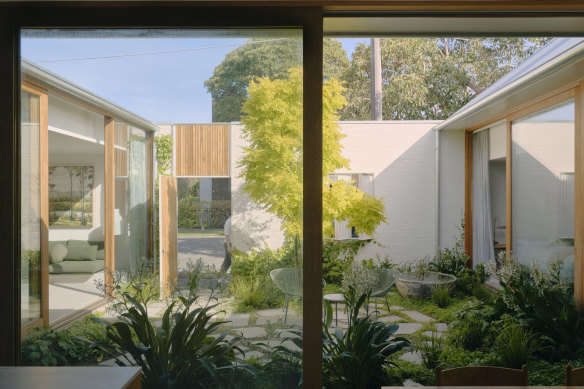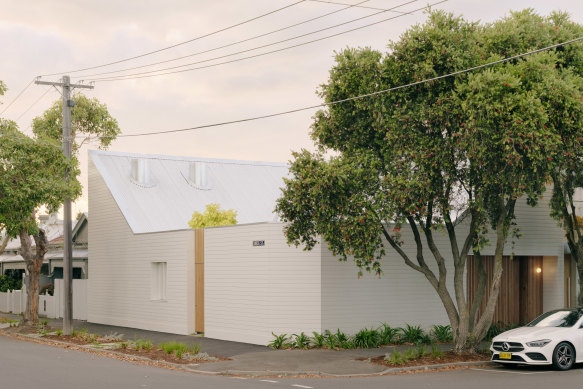- Business
- Consumer affairs
- Architecture
This was published 8 months ago
Overcoming heritage controls to design award-winning home
Heritage areas such as Albert Park can be tough places to design anything with a contemporary whiff.
Architects who succeed often point to modest insertions concealed behind pitched roofs. Few get as far as Clare Cousins Architects, who managed to create a new courtyard-style house in one of the most controlled heritage precincts in Melbourne, an effort to be applauded.

The contemporary Albert Park home designed by Clare Cousins Architects.Credit: Tom Ross
This, along with the impressive result, was acknowledged by the Victorian chapter of the Australian Institute of Architects when they gave it an award.
As with all things related to heritage, architect Clare Cousins consulted engineers as well as conservation specialists RBA Architects. They concluded the former late-Victorian timber building, once a corner store, was well past its use-by date. “There was mould on the walls and many of the timber boards were disintegrating.”
The main feature, the chamfered edge, was the only characteristic Roger Beeson from RBA, could find that was worth acknowledging as a touchstone to the past, says Cousins, who didn’t want to rebuild in a faux-Victorian style.
For the clients, a couple with adult children and grandchildren, the corner site, approximately 220 square metres in area, provided the opportunity to build a new house with themselves in mind rather than, as the catchcry goes, “for resale”.
“It was designed purely for them and for their grandchildren to occasionally stay over,” says Cousins, pointing out the two modest-sized attic-style bedrooms and small lounge tucked into the raked roof. Given it’s for them, Cousins and her team could break down some of the privacy issues normally associated with a family home – allowing bedrooms and even bathrooms to be visible from the courtyard garden at the core of the site.
The form of the house, just 180 square metres in area, was not only derived from the size of the plot, but also by a neighbouring two-storey home on the northern edge. “We spent a considerable amount of time seeing where the maximum amount of sunlight would penetrate our client’s site,” says Cousins, pointing out the courtyard garden designed by Eckersley Garden Architecture.
Cousins created a chamfered edge on the corner, as well as using timber for the new house, evocative of the corner store. As with the store, the timber fence enclosing the courtyard abuts the pavement on one side and on the other a timber battened screen signals the main front door.
But unlike many Victorian homes, there’s a degree of transparency with both elevations, including a canteen-style window with operable timber blades that can be adjusted by the owners to manipulate views into the garden. Likewise, the pivotal windows set behind the timber-battened screen articulating the main entrance strengthen the connection to the street, as well as providing cross-ventilation – let’s face it, some single-fronted Victorian homes can feel a bit stuffy in their original configuration.

The form of the house, just 180 square metres in area, was not only derived from the size of the plot, but also by a neighbouring two-storey home on the northern edge.Credit: Tom Ross
Given this house is for a couple, the spaces are more than sufficient – a lounge immediately inside the entrance with a curvaceous suite designed by Cousins, which flows into the kitchen and dining area. As with the kitchen and living areas, the main bedroom and en suite benefit from unimpeded views of the courtyard – even from the shower.
“We used rippled glass for the more private areas in the bathroom, but really does it matter if they see each other showering from the garden?” says Cousins.
At a time when discussion on design tends to focus on finishes, such as wall-to-wall marble as a sign of success, it’s refreshing to see that a simple palette of materials can find its own rewards. The kitchen, for example, features a simple stone bench, a quartzite splashback and American oak timber veneer joinery. Likewise, the ‘floating’ timber treads of the staircase allow for both light and views into a pocket-sized courtyard next to the garage. There was also enough room for a small study nook below the stairs.
The courtyard house shows what can be achieved on a modest site set in a heritage precinct. It might not come with the home theatre, the gymnasium or the parents’ retreat but in essence it is a retreat in a densely built area, celebrating the garden as much as the pleasure that comes from living in an award-winning home.
The Market Recap newsletter is a wrap of the day’s trading. Get it each weekday afternoon.